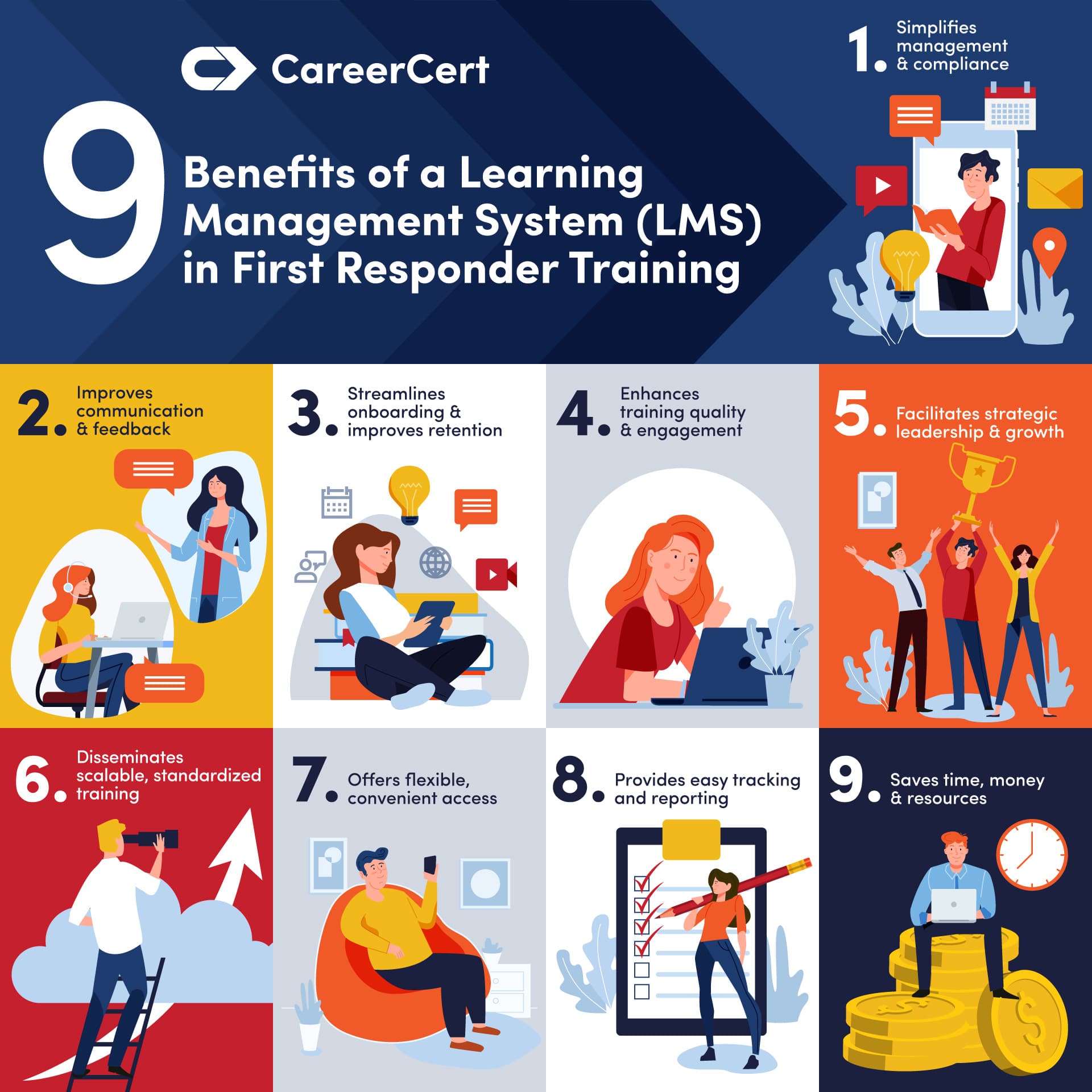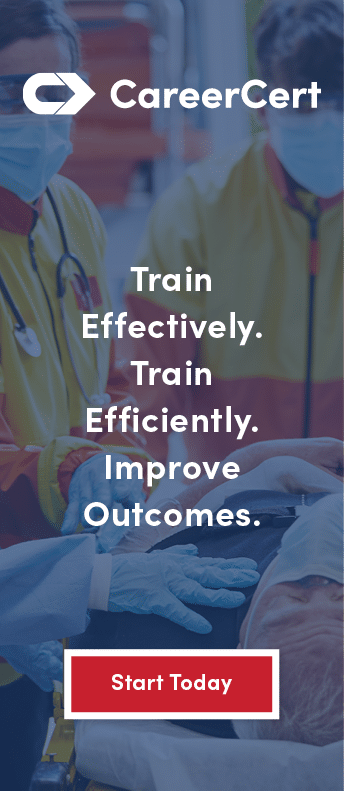Benefits of Using an LMS in Emergency & Healthcare Training
Synopsis
This article discusses how learning management systems can improve patient outcomes within the emergency and healthcare setting by exploring the benefits of learning management systems, how those benefits can solve current challenges in the healthcare industry, and what criteria emergency and healthcare leaders should look for in a learning management system.
Introduction
Learning management systems (LMS) are the backbone of the eLearning movement. For many forms of learning, an LMS provides less expensive and more efficient training compared with classroom learning, which is why they are being adopted across multiple industries.2,3 Between 2013 and 2022, the LMS market is anticipated to grow from $2.5 billion to $15.72 billion as more industries adopt learning management systems.1
How can learning management systems impact the emergency and healthcare industries? How can they help leaders overcome current industry challenges to improve patient outcomes?
To answer these questions, we must first cover:
- What an LMS is
- What benefits are associated with an LMS
- How LMS incorporation can impact the healthcare industry
- What to look for in a successful LMS
What is an LMS?
An LMS is an online platform that provides learners with a single place to access training, education, resources, exams, and contact with instructors and leaders. An LMS also provides leaders with easy communication with learners, access to data (including courses taken, learner performance, etc.), reports, and more. You can think of an LMS like the frame of a house that holds the walls, electrical wires, plumbing, floors, and roof together. Instead of holding physical materials together, a learning management system, often called a training platform in industries outside of educational settings, encompasses a group of technologies or applications that are built within the same framework to provide a consistent, comprehensive training experience.4
In “Learning management system and e-learning tools,” David Back et al. discuss the role of an LMS within medical education:
“The provision of e-learning tools or complex blended learning scenarios depends on an online platform where students and teachers can get access to them. To address this issue, different forms of learning management systems (LMS) were established in medical faculties worldwide. An LMS can be defined as software that automates the administration, tracking, and reporting of training events and delivers learning contents rapidly. It also enables the provision of a structured curriculum, and eases both the accessibility of many contents and an all-in-one organization.”5
What are the benefits of an LMS?
The benefits of a learning management system are expansive, but within the healthcare setting, the most important benefit includes improved provider and patient outcomes.
A study in the Journal of Surgical Education demonstrated how surgical residents “who used a structured LMS performed significantly better [on their American Board of Surgery In-Training Examination] than their counterparts who used an unstructured approach.”6
In another study published by the Journal of Higher Education Theory and Practice, Donghyun Kim notes that LMS usage is positively associated with academic performance:
“The availability of course materials that LMS provides positively impacts the ability for students to learn in and outside of the classroom. The learning skills of students has improved in courses where LMS are available (Nair and Patil 2012). This improvement in learning can be attributed to the learning environment that LMS provides and the access to course material and instant results that allows students to pursue knowledge in a more efficient manner (Ebardo and Valderama 2009). Additionally, the communication that LMS provides between students and instructors allows for feedback and comments on work completed help to promote healthier academic goals in students course work.”7
Students also identify learning management systems as “among the most important instructional technologies for their academic success.”8

Other LMS benefits observed across a variety of industries include:
- Saved time, money, and resources 9, 10, 11
- Centralized organization and more efficient management 9, 10
- Easy access to standardized, unlimited, updated information 9, 10
- Customization and scalability for unique needs 9, 11
- Advanced tracking and reporting of progress and performance 9, 10
- Serves different learning styles and incorporates multimedia learning 9, 13
- Improved communication and employee engagement 10, 12, 14
- Integrates a variety of learning and training experiences 10
- Keeps organizations up to date with compliance regulations 11
- Flexibility, independence, and convenience for the learner 11, 13
- Simplifies onboarding and other training processes 12
- Provides a competitive advantage to attract and retain employees 12</sup
- Increases learning interactivity and engagement 13, 14
- Provides immediate feedback, community building, and connection to experts 13
- Improved education quality and accessibility of resources 14
- Facilitates strategic leadership and management 14
- Supports different needs and promotes inclusion 14
How can healthcare industries benefit from an LMS?
Each of these benefits contributes to the overarching goal of improving emergency and healthcare outcomes. Just as healthcare organizations are working together to share data that impacts patient care, healthcare companies can internally promote and standardize provider access to education that elevates patient care.
The need for providers to have access to quality, reliable, and documented training has never been greater. In 2020, it’s estimated that the world’s medical knowledge doubled every 73 days.15 Providing the training necessary to keep pace with this advancement requires consistency, immediate access, innovation, organization, and continuous education. Learning management systems are a key factor in helping providers become effective and persistent learners5 and more adept providers.
From an administrative standpoint, learning management systems can mitigate risk by building and testing clinical readiness. Among the top-used LMS tools across industries are learning paths, blended learning, and assessment tools.1 By implementing platforms that track compliance and provide regular knowledge checks to assess content mastery, healthcare leaders can quickly identify and improve provider standards of care.
Learning management systems also empower employees to become active shapers of their education. According to a 2018 LinkedIn Workplace Learning Report, 68% of employees prefer to learn within the workplace and 58% favor self-paced learning.16 Learning management systems allow providers to connect to training that fits diverse learning styles, receive feedback from industry experts, and learn how and when it works best for them.
In addition, an LMS will familiarize employees with online tools and resources that can impact patient care. In “Using Technology to Meet the Challenges of Medical Education,” Phyllis A. Guze notes:
“The explosion of medical knowledge no longer allows physicians to keep in their mind all knowledge that is necessary to provide quality patient care. It is estimated that more than 600,000 articles are published in biomedical literature every year. If a student attempted to keep up with the literature by reading 2 articles per day, in 1 year this conscientious individual would be more than 800 years behind.”
Instead of working in isolation, medical professionals must learn how to quickly and efficiently utilize technology to improve patient care, something an LMS can facilitate.
Lastly, learning management systems can save healthcare companies time, money, and resources. Surveys compiled from 2,500 companies across the United States demonstrated that 42% of businesses reported increased income as a result of an LMS or training program. Reports indicated a 24% increase in profit margins and a 218% higher revenue for each employee.17 In “The Value of Training,” IBM reported a return of $30 for every $1 spent on eLearning.18
What makes a successful LMS in healthcare?
Despite these positive examples, it is important to note that “having access to an LMS does not necessarily mean that learning has occurred effectively.”19 An LMS must meet key criteria to positively impact patient outcomes.
Sufficient support to effectively implement the LMS.
Multiple studies on the integration of LMS into educational settings have found that student and teacher use of, benefits from, and satisfaction with an LMS increases when they have adequate support and training on how to use the program or system.20, 21 As Lee Yen Chaw and Chun Meng Tang summarize in “What makes learning management systems effective for learning?” system quality and service quality “had a significant relationship with system use. In turn, system use had a significant relationship with learning effectiveness.”19 LMS and training programs that incorporate quality service result in the best learning outcomes.
Convenience and ease of use for learners.
As mentioned above, the majority of employees prefer learning at work and at their own pace. An LMS should provide flexibility and convenience so employees can learn when and where it works best for their schedules, including on mobile devices, which is quickly becoming the preferred learning device.22
These systems should employ a mentality that prioritizes the user experience because perceived ease of use impacts perceived usefulness as well as how often learners will turn to an LMS as a resource.23
Back et al. share that student priorities for electronic tools include a uniform, single-sign-in platform that is easy to operate, time-saving, and clearly structured. The study notes, “When asked about the most important key characteristics of LMS and online tools which support their learning, the students ranked the ‘Top 5’ with clarity (98.3%), teaching-related contents (92.7%), ease of use (92.5%), practice-orientation (91%) and time-saving (85.2%).”5
Incorporates extensive tracking, data, and reports.
In a study on quality improvement programs in the prehospital setting, Erin W. Lincoln et al. observe:
“Compliance with system clinical guidelines and protocols . . . does not ensure continuous quality improvement. While compliance is critical to ensure baseline performance, these performance indicators will likely be indicative of any necessary changes to implement. Essentially, baseline protocol compliance and quality assurance can be paired with quality improvement projects and initiatives to improve clinical outcome.”24
Identifying those areas for quality improvement require extensive data. Within the healthcare industry, tracking all the components of compliance requires organization and nuance. An LMS should provide tools and reports that simplify this process and reduce employee license or certification lapses. More importantly, an LMS should provide refined data on provider performance and clinical readiness to help leaders identify areas of improvement, mitigate gaps, and implement new training or initiatives that improve patient care.
Provides dynamic, customizable, and flexible options.
According to a survey from eLearning Industry, “functionality and price are the two most important factors to organizations when looking into purchasing LMS software.”1 While emergency and healthcare teams have many overlapping roles and functions, each serves unique populations and has specific training needs and requirements. For an LMS to provide your employees with an easy, one-sign-in solution, it must be customizable and meet department-specific criteria. In addition, it should offer a wide variety of courses that consider the training needs of different providers, instructors, supervisors, and leaders. An LMS should easily integrate with your current training and compliance requirements to create a seamless learning experience.5
Facilitates engagement and clear communication.
As Back et al. note, learners demonstrate a strong desire for active involvement in learning, “thus, e-learning offerings should include the possibility of interaction to promote the acquisition of knowledge.“5
Interaction and engagement are critical components to learner satisfaction and performance.5, 26 Just as the presence of an LMS cannot ensure learning, the presence of multimedia cannot ensure interaction unless learning modules are conscientiously designed to require interaction. Games, discussions, interactive scenarios, knowledge checks, videos, and other audio-visuals should be incorporated into the content in ways that facilitate engagement and learning. In addition, an LMS should promote engagement even outside of virtual classrooms with frequent communication, notifications, and reminders. In the study conducted by Back et al., learners frequently mentioned the importance of reminders and notifications to help them stay updated with course materials and training.
Matches latest best practices with best modalities and technologies.
The number one reason students use an LMS is for the acquisition of information, which is why practice orientation is listed among the top 5 key characteristics of an LMS.5
Employees use an LMS to learn skills quickly and effectively.5 However, certain learning objectives are accomplished most effectively with different learning modalities or technologies. For example, virtual instructor-led training can help deepen a provider’s understanding of complex or nuanced topics through discussion, interaction, case studies, and immediate feedback from industry experts.26, 27 In contrast, virtual reality training or high-fidelity simulations can provide deliberate practice, build critical thinking and communication skills, and test field readiness in a safe but realistic environment.27, 28
As Cook et al. note in “Comparative effectiveness of technology-enhanced simulation versus other instructional methods,” “deliberate alignment of objectives and instructional modalities will likely enhance efficiencies for both cognition (eg, optimal management of cognitive load) and costs (time and monetary investment). For example, educators might use less costly interventions (eg, lecture or Web-based learning) for nonskill objectives and reserve simulation for later stages of instruction.”29
A successful LMS should be frequently updated to include the latest, research-based best practices and pair course materials with the modalities and technologies that will best facilitate provider learning and performance.
As industries worldwide begin adopting learning management systems, emergency healthcare leaders have the opportunity to innovate and lead out on this cultural shift. The benefits of learning management systems can be tailored to solve problems and challenges unique to the healthcare industry. As we seek to build and find learning management systems that 1) provide sufficient user support, 2) offer convenient, easy-to-use tools, 3) track compliance and critical data, 4) provide dynamic, customizable solutions, 5) promote interactive learning, and 6) match best practices with the best available modalities and technologies, we will be able to better improve department, provider, and patient outcomes.
- Browne R. 7 Key LMS Statistics and Why They Matter. Learn.g2.com. https://learn.g2.com/lms-statistics. Published 2020. Accessed September 1, 2020.
- Rhode J, Richter S, Gowen P, Miller T, Wills C. Understanding Faculty Use of the Learning Management System. Online Learning. 2017;21(3). doi:10.24059/olj.v21i3.1217
- Top Learning Management System Statistics For 2020. eLearning Industry. https://elearningindustry.com/top-learning-management-system-lms-statistics-for-2020-infographic. Published 2020. Accessed September 1, 2020.
- Bridgwater A. What’s The Difference Between A Software Product And A Platform?. Forbes. https://www.forbes.com/sites/adrianbridgwater/2015/03/17/whats-the-difference-between-a-software-product-and-a-platform/#2745542c56a6. Published 2020. Accessed September 1, 2020.
- Back D, Behringer F, Haberstroh N, Ehlers J, Sostmann K, Peters H. Learning management system and e-learning tools: an experience of medical students’ usage and expectations. Int J Med Educ. 2016;7:267-273. doi:10.5116/ijme.57a5.f0f5
- Dua A, Sudan R, Desai S. Improvement in American Board of Surgery In-Training Examination Performance With a Multidisciplinary Surgeon-Directed Integrated Learning Platform. J Surg Educ. 2014;71(5):689-693. doi:10.1016/j.jsurg.2014.02.007
- Kim D. The impact of learning management systems on academic performance: Virtual competency and student involvement. Journal of Higher Education Theory and Practice. 2017; 17(2): 23-35.
- Rhode J, Richter S, Gowen P, Miller T, Wills C. Understanding Faculty Use of the Learning Management System. Online Learning. 2017;21(3). doi:10.24059/olj.v21i3.1217
- 9 Advantages of Learning Platforms or LMS. CAE Computer Aided E-learning. https://www.cae.net/lms-learning-platforms-advantages/. Published 2020. Accessed September 1, 2020.
- 9. The Top 8 Benefits Of Using Learning Management Systems – eLearning Industry. eLearning Industry. https://elearningindustry.com/top-8-benefits-of-using-learning-management-systems. Published 2020. Accessed September 1, 2020.
- The Benefits of Learning and Teaching via Online Platforms | Onrec. Onrec.com. https://www.onrec.com/news/news-archive/the-benefits-of-learning-and-teaching-online-platforms. Published 2020. Accessed September 1, 2020.
- Employee Training Software | Leveraging 7 Key Benefits In 2020. Selecthub.com. https://www.selecthub.com/learning-management/5-reasons-need-employee-training-software/. Published 2020. Accessed September 1, 2020.
- The 12 Benefits of eLearning for Employee Training and Development. TalentLMS Blog. https://www.talentlms.com/blog/benefits-of-elearning-in-the-workplace/. Published August 8, 2019. Accessed September 1, 2020.
- The 12 key benefits of learning platforms: How learning platforms support the business of teaching and learning. Itslearning AS. https://old.taltech.ee/public/h/haridustehnoloogiakeskus/img/12_reasons_web_final-3.pdf. Published 2011. Accessed September 1, 2020.
- Densen P. Challenges and opportunities facing medical education. Trans Am Clin Climatol Assoc. 2011;122:48–58.
- LinkedIn’s 2018 Workplace Learning Report. Workplace Learning & Development Report 2018 | LinkedIn Learning. https://learning.linkedin.com/resources/workplace-learning-report-2018#. Accessed September 1, 2020.
- The worldwide market for mobile learning products and services. Ambient Research. Accessed September 1, 2020.
- The value of training. IBM Training. https://www.ibm.com/services/learning/pdfs/IBMTraining-TheValueofTraining.pdf. Published 2014. Accessed September 1, 2020.
- Chaw L, Tang C. What Makes Learning Management Systems Effective for Learning?. Journal of Educational Technology Systems. 2018;47(2):152-169. doi:10.1177/0047239518795828
- Zheng Y, Wang J, Doll W, Deng X, Williams M. The impact of organisational support, technical support, and self-efficacy on faculty perceived benefits of using learning management system. Behav Inf Technol. 2018;37(4):311-319. doi:10.1080/0144929x.2018.1436590
- Grabar I, Rajh I. Using learning management systems in ESP: Students’ perceptions and actual benefits. 7th International Language Conference on the Importance of Learning Professional Foreign Languages for Communication Between Cultures. 2014.
- Adzharuddin N. Learning Management System (LMS) among University Students: Does It Work?. International Journal of e-Education, e-Business, e-Management and e-Learning. 2013. doi:10.7763/ijeeee.2013.v3.233
- Zakaria N, Jamal A, Bisht S, Koppel C. Embedding a Learning Management System Into an Undergraduate Medical Informatics Course in Saudi Arabia: Lessons Learned. Med 2 0. 2013;2(2):e13. doi:10.2196/med20.2735
- Lincoln EW, Reed-Schrader E, Jarvis JL. EMS, quality improvement programs. Updated 2019 Jul 28. Treasure Island (FL): StatPearls Publishing; 2020.
- Croxton RA. The role of interactivity in student satisfaction and persistence. Journal of Online Learning and Teaching. 2014; 10(2):314-325.
- Cook D, Levinson A, Garside S, Dupras D, Erwin P, Montori V. Instructional design variations in internet-based learning for health professions education: A systematic review and meta-analysis. Academic Medicine. 2010;85(5):909-922. doi:10.1097/acm.0b013e3181d6c319
- Health Scholars. Evidence brief: Health Scholars’ fire in the ORTM virtual reality simulation. July 15, 2018. Accessed November 1, 2018. https://healthscholars.com/fire-in-the-or-evidence-paper/
- Lea M. How virtual training is set to change nursing education. HealthTech. May 20, 2020. Accessed June 1, 20202. https://healthtechmagazine.net/article/2020/05/how-virtual-training-set-change-nursing-education.
- Cook D, et al. Comparative effectiveness of technology-enhanced simulation versus other instructional methods. Simulation in Healthcare: The Journal of the Society for Simulation in Healthcare. 2012;7(5):308-320. doi:10.1097/sih.0b013e3182614f95




